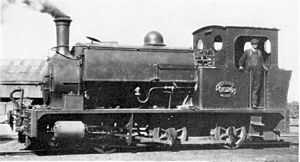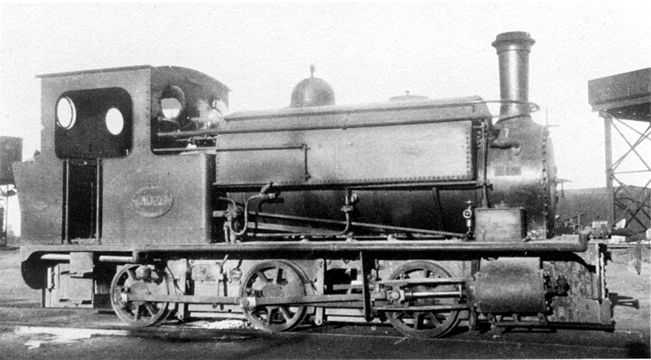CGR 0-6-0ST 1902
| CGR 0-6-0ST 1902 ex Harbour Board EL 0-6-0ST 1902 to South African 0-6-0ST 1902 | |
|---|---|
|
Ex Harbour Board East London no. 2, later CGR no. 1028, then SAR no. 01028, c. 1920 | |
| Type and origin | |
| Power type | Steam |
| Designer | Hunslet Engine Company |
| Builder | Hunslet Engine Company |
| Serial number | 793-794 |
| Build date | 1902 |
| Total produced | 2 |
| Specifications | |
| Configuration | 0-6-0ST |
| Gauge | 3 ft 6 in (1,067 mm) Cape gauge |
| Driver diameter | 33 in (838 mm) |
| Wheelbase | 10 ft 5 in (3.175 m) |
| Length | 23 ft 3 3⁄4 in (7.106 m) over couplers |
| Height | 10 ft 1 in (3.073 m) |
| Axle load | 8 2⁄20 long tons (8.2 t) front driver |
| Weight on drivers | 20 4⁄20 long tons (20.5 t) w/o |
| Locomotive weight | 20 4⁄20 long tons (20.5 t) w/o |
| Fuel type | Coal |
| Fuel capacity | 3⁄4 long ton (0.8 t) |
| Water capacity | 400 imp gal (1,800 l; 480 US gal) |
| Boiler | 5 ft 2 3⁄4 in (1.594 m) pitch |
| Boiler pressure | 140 psi (970 kPa) |
| Firegrate area | 6.38 sq ft (0.593 m2) |
| Heating surface: – Tubes | 326 sq ft (30.286 m2) |
| – Firebox | 36 sq ft (3.3 m2) |
| – Total | 362 sq ft (33.6 m2) |
| Cylinders | Two |
| Cylinder size |
10 1⁄2 in (267 mm) bore 16 in (406 mm) stroke |
| Valve gear | Stephenson |
| Performance figures | |
| Tractive effort | 6,150 lbf (27.4 kN) at 75% pressure |
| Career | |
| Operator(s) |
East London Harbour Board Cape Government Railways South African Railways |
| Number in class | 2 |
| Number(s) |
ELHB 1-2, CGR 1027-1028, SAR 01027-01028 |
| Delivered | 1902 |
| First run | 1902 [1][2] |
The CGR 0-6-0ST of 1902 is a South African steam locomotive from the pre-Union era in the Cape Colony.
In 1902 two 0-6-0 saddle-tank locomotives entered shunting service at the East London Harbour. They were taken onto the Cape Government Railways roster in 1908 and both were still in service when the South African Railways was established in 1912.[1][2]
Manufacturer
Two 0-6-0 saddle-tank locomotives were delivered from Hunslet Engine Company to the East London Harbour Board in 1902, with works numbers 793 and 794, ex works in August and September 1902 respectively. Numbered 1 and 2 with number plates on their tanks and plates reading "EAST LONDON HARBOUR BOARD" on their cabsides, they were placed in service as harbour shunters at East London Harbour.[1][2]
Service
In 1908 both locomotives were taken onto the Cape Government Railways (CGR) roster and renumbered to 1027 and 1028.[1]
The Union of South Africa was established on 31 May 1910, in terms of the South Africa Act. One of the clauses in the Act required that the three Colonial Government railways, the CGR, the Natal Government Railways and the Central South African Railways, also be united under one single administration to control and administer the railways, ports and harbours of the Union. While the South African Railways (SAR) came into existence in 1910, the actual classification and renumbering of all the rolling stock of the three constituent railways required careful planning and was only implemented with effect from 1 January 1912.[3][4]
In 1912 the two locomotives were considered obsolete even though they were only ten years old. As obsolete stock they were renumbered by having the numeral 0 prefixed to their existing numbers. Even so, they remained in service into the 1930s.[1][2][4]
Sides illustrated
The main picture and the following illustrate both sides of engine no. 01028 while in South African Railways service.
See also
- List of South African locomotive classes
- South African locomotive history
- The 0-6-0 wheel arrangement
References
|
- ↑ 1.0 1.1 1.2 1.3 1.4 Holland, D.F. (1972). Steam Locomotives of the South African Railways, Volume 2: 1910-1955 (1st ed.). Newton Abbott, Devon: David & Charles. p. 125-126. ISBN 978-0-7153-5427-8.
- ↑ 2.0 2.1 2.2 2.3 Paxton, Leith; Bourne, David (1985). Locomotives of the South African Railways (1st ed.). Cape Town: Struik. p. 26. ISBN 0869772112.
- ↑ The South African Railways - Historical Survey. Editor George Hart, Publisher Bill Hart, Sponsored by Dorbyl Ltd., Published c. 1978, p. 25.
- ↑ 4.0 4.1 Classification of S.A.R. Engines with Renumbering Lists, issued by the Chief Mechanical Engineer’s Office, Pretoria, January 1912, p. 17. (Reprinted in April 1987 by SATS Museum, R.3125-6/9/11-1000)

